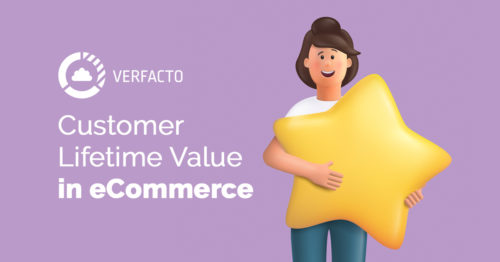Every customer brings value to your business. The question is: how much value? What turns your customers into loyal fans? How long do they stay around? Is there a way to increase your profits during a client’s lifetime?
The answer is yes! This is why in this article, we will show you exactly how to increase Customer Lifetime Value in a few simple steps.
Keep on reading!
What is Customer Lifetime Value?
Customer Lifetime Value in eCommerce (CLV, LTV, CLTV) is a marketing metric that represents the total amount spent by a single customer on your products or services over their lifespan. CLV is all about customer retention and satisfaction.
So, one of the ways to effectively grow your business is to retain your existing customers and increase their lifetime value. The longer your satisfied customer stays with you, the more profit he/she brings to your business.

Retain your customers with a loyalty program that they want! Start in minutes and see your customers coming back.
Why is CLV Important To Your Business Growth?
CLV helps you to make more accurate financial predictions for your business, as well as making better decisions for your marketing strategy. As you can understand how much profit a client will bring you during its lifetime, it’s easier to have clarity about things like your customer acquisition marketing costs.
It also helps you to see more clearly if you can or should do something to improve the customer relationships with your brand. By taking a closer look at such things like average order value and average purchasing frequency, and comparing them to previous data it’s possible to adjust strategies that lead your company to improve customer lifetime.
If it’s still not clear, here are a few more reasons why CLV is important:
Existing customers spend more than new customers. Studies have shown that existing customers spend 67% more than new customers.
Keeping existing customers costs five times less than attracting new ones. Acquiring new customers by reaching out to them, bringing them through a marketing funnel, and onboarding them is costly while existing customers already went through these processes.
Existing customers are more likely to buy. The probability of selling to an existing customer is 60-70%, while the probability of selling to a new customer is only 5-20%. Moreover, increasing the customer retention rate by only 5% increases profits by 25-95% (see more on how to increase retention with cohort analysis here).
But the surprising thing is that about 50% of companies choose to put greater focus on their customer acquisition strategy vs. 18% that focus on retention. By knowing the above statistics, we can see that Customer Lifetime Value is an important metric that is not explored as much as it should be.
However, that’s good news for you! By focusing on it, you have an advantage and can stay ahead of some of the competition. So, let’s dive into how you can calculate Customer Lifetime Value and then increase it.
How To Calculate The CLV of Your Business?
To calculate your Customer Lifetime Value, we will need to calculate a few numbers.
- Average order value: divide your company’s total revenue over a period of time by the total orders your customers made during that time frame.
- Average purchase frequency rate: divide the total number of purchases by the number of unique customers who made purchases during that time period.
- Average customer lifespan: average the number of years a customer continues purchasing from your company.
- Customer lifetime value: multiply the average order value by the average purchase frequency and then by the average customer lifespan. This helps you identify how much revenue you can expect to generate from a customer over the life of their relationship with your company.
Once you have these numbers, you can predict customer lifetime value with more accuracy.
What’s the Formula for Measuring Customer Lifetime Value?

There are several ways you can calculate customer lifetime value (CLV). One of them is by multiplying the average order value by the average purchase frequency and then by the average customer lifespan. This helps you identify how much revenue you can expect to generate from a customer over the life of their relationship with your company.
Therefore, the formula would be:
AOV x APF x ACL = CLV
Calculating Customer Lifetime Value: Practical Example
The average sales in a Sports e-shop are $120 and. On average, a customer shops two times a year for two years. The customer lifetime value is calculated as:
AOV($120) x purchase frequency(2) x lifespan (2) = $480
Calculating the lifetime value can assist you in estimating future revenue and the number of customers you need to obtain to achieve profit.
For example, when you know your average CLV, it’s easy to identify your maximum price for customer acquisition. Simply multiply CLV by your profit margin. Let’s use the industry average of 15% as an example:
CLV($480) x profit margin(15%) = $72
This means that if you spend more than $72 to acquire a customer you are likely to operate at a loss.
How To Increase Customer Lifetime Value?
Focusing on Customer Satisfaction and Customer Retention is the way to increase lifetime value of your customers (learn more about retention metrics here). Here are 5 effective ways how this can be achieved and maintained.
1. Offer a Referral Program
Referral programs are a great way to increase customer lifetime value. Referred customers have 16% higher lifetime value and 18% less churn (also known as customer attrition). Furthermore, 81% of consumers trust recommendations from people they know, and 55% of people share their new purchases on social networks.
This means that by offering a referral program, you improve your CLV and get the additional benefit of exposure to new possible customers, which then can be turned into loyal customers.
2. Provide Targeted, Personalized Campaigns
56% of digital marketers agree that email marketing is the most effective digital marketing tactic for customer retention. However, many businesses fail to deliver meaningful content. Instead of providing valuable content, they limit themselves with automated campaigns without offering any real value.
Sending targeted and personalized campaigns lets you focus on specific customers and help them be engaged with content specifically tailored to them. Check AI-suggested personalization for specific groups of your customers with Verfacto.
3. Put Them First – Hear Your Customers

Whether the majority of your customers are happy or not, you’ll notice by your business performance. But to measure their satisfaction more accurately, always collect the necessary data. In this case, a short survey works well. In there, you can include:
- On a scale from 1 to 10, whether the customer would recommend your products to someone else.
- Where could things be improved (product description, presentation, delivery costs, etc.)
- Optional short comment for any additional feedback.
Giving your customers a way to share their feedback makes them an important part of your business growth. By listening to customers’ feedback and improving where you can, they will appreciate the effort and will likely continue to stay loyal to your brand.
4. Create Content to Keep Customers Engaged
Content marketing is here to stay, and it definitely helps your customers feel closer and more engaged with your brand – especially if you do it right. When you create content focusing on your customer’s common pain points, or focused on educating and leading your leads through the sales funnel, you have much more chances to increase CLV and decrease the cost for acquiring customers.
When customers develop a relationship to your brand they will not only be loyal to you for longer, but also help promoting your brand through their social media platforms or word-of-mouth. When they are your biggest fans, chances are they purchase more and more often from you too, and publishing content that is helpful to them – be it on your blog, social media or through e-mail marketing – is a great way to do so.
5. Optimize Your Customer Service
Better customer service leads to a better customer experience which, as a result, increases customer retention and improves customer lifetime value. Make sure your business is active on multiple social media channels, as 66% of customers use at least 3 different communication channels to contact support.
Then, look into which channels your clients use the most and allocate resources accordingly. Clients usually expect a fast response to their questions, requests, and complaints, so ideally, you should provide 24/7 live chat support.
However, if you don’t have the means to do that, respond to clients as fast as possible, as 84% of consumers expect a response within 24 hours if they post complaints on social media.
6. Reward Your Most Loyal Clients

By calculating your lifetime value of every customer, you will see which customers are the most loyal to you (see it in one click with Verfacto). This is a perfect time to foster your relationships with these customers by giving them special offers. These offers can include cheaper (or free) shipping, early access to new items and guaranteed order availability for limited and exclusive stock, and more.
Rewarding your most loyal customers will undoubtedly increase their satisfaction and retention long term.
7. Benefit from Cross-Selling and Upselling Strategies
Another way to increase customer lifetime value is by using strategies like upselling and cross-selling. The goal here is to offer better solutions for your customers while increasing their average order value or even purchase frequency.
While showing customers a complementary product or service to the one they are currently researching or by presenting them a better option with a higher price and more benefits, you increase your chances to increase your revenue.
These are great strategies used by several online businesses that are worth trying. You can also benefit from strategies like contextual targeting, to make sure your customers get the right ads at the right time.
FAQ
What is a good customer lifetime value?
A good customer lifetime value varies according to your niche, market, and your costs. There’s no exact number that can be considered a “good customer lifetime value”. However, a good CLV should always be higher than your customer acquisition cost and the amount you spend to retain your customers.
What affects CLV?
Anything that affects directly or indirectly the average order value, the average purchase frequency and the average customer lifespan affects your CLV.
A few factors that might affect customer lifetime value – positively or negatively – are:
- Pricing
- Billing
- Product offering
- Quality of products
- Branding
- Sales strategies (upselling and cross-selling)
- Content creation/social media presence
- Customer service
- Referral programs
- Loyalty programs
Implement LTV attribute into your PPC, Email or On-site marketing campaigns and. Use it as a custom trigger or a way to segment your audience.



